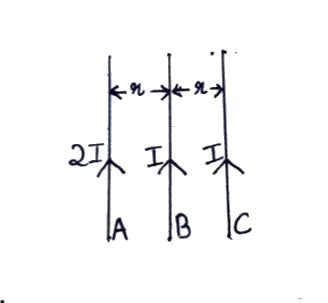There straight current carrying conductors A,B and C are placed parallel and adjacent to each other by an electrician as shown in the figure. Then determine the direction of resultant force acting on the wire B .

Direction of current flowing through the wire '1' is from a to B and in wire '2' is from C to D, i.e. the current flows through the wires in the same direction. According to right hand grip rule the direction of magnetic field at the point 'P' due to the wire '1' is into the plane of the paper and that of the wire '2' is out of the plane of the paper so net magnetic field at the midpoints is zero. when the polarity of cell 'C1' changes, current flows through the wire from B to A. so, the direction of magnetic field at the point 'P' due to the two wires is out of plane of the paper. So, net magnetic field is away from the plane of the paper.
Topper's Solved these Questions
Similar Questions
Three straight wires A,B and C are placed in a plane parallel to each other and separated by equal distance, carrying currents as shown in the figure. Determine the direction of force on B

View SolutionThree infinitely long parallel straight current carrying wires A, B and C are kept at equal distance from each other as shown in the figure . The wire C experiences net force F .The net force on wire C, when the current in wire A is reversed will be

View Solution
Knowledge Check
Three infinitely long parallel straight current carrying wires A, B and Care kept at equal distance from each other as shown in the figure. The wire C experiences net force F. The net force on wire C, when the current in wire A is reversed will be :
 AZeroBF2CFD2F
AZeroBF2CFD2FThree very long straight current carrying conductors are placed parallel to each other as shown in. The conductors A and C are fixed whereas conductors B is free to move. If the conductor B is pulled towards right through a very small distance r, then what is the net force acting on it and the angular frequency of the resulting oscillation.
 Aμ02II0πd2, √μ0II0πmd2Bμ02II04πr2, √μ0II02πmd2Cμ0II02πr2, √μ0II04πmdDμ0II02π[(d+r)−(d−r)d2−r2], √μ0II0πmd2
Aμ02II0πd2, √μ0II0πmd2Bμ02II04πr2, √μ0II02πmd2Cμ0II02πr2, √μ0II04πmdDμ0II02π[(d+r)−(d−r)d2−r2], √μ0II0πmd2A circular loop is placed near a current carrying conductor as shown in figure. Find the direction of induced current, if the current, in the wire is decreasing.
 AclockwiseBAnti-clockwiseCfirst clockwise then anti-clockwiseDnone of these
AclockwiseBAnti-clockwiseCfirst clockwise then anti-clockwiseDnone of these
A short current carrying conductor is placed perpendicular to the axis of a current carrying ring as shown. The direction of force acting of the conductor is

View SolutionA straight conductor of length ro carrying a current l is placed perpendicular to a long straight conductor which carries a current io as shown in the figure. Find the force of interaction between them.

View SolutionA current carrying squre loop is placed near an infinitely long current carrying wire as shown in figure . The loop torque acting on the loop is

View SolutionThere long straight wires A, B and C are carrying current as shown figure. Then the resultant force on B is directed

View SolutionP, q and R are long straight wires in air, carrying currents as shown in the figure. The force on Ois directed

View Solution
